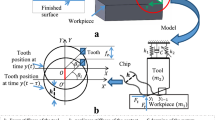Abstract
In machining processes, the specific cutting energy increases nonlinearly as the uncut chip thickness decreases. This phenomenon is called the size effect and can be classified into two types by its cause—geometric and intrinsic. The geometric size effect is caused by the decrease of the effective rake angle with the decrease of the uncut chip thickness when the tool has a finite radius of the cutting edge. The intrinsic size effect results from the nature of the material, in which the resistance against plastic deformation (flow stress) increases as the length scale of the material deformed decreases. In order to improve the prediction accuracy of a cutting force model in micro-machining, it is important to understand each of these size effects and reflect them into the cutting force model accurately. In this regard, this study develops an experimental method to decouple the geometric and intrinsic size effects and models them individually. Based on this, a mechanistic cutting force model including the geometric and intrinsic size effects in separate terms is constructed and compared to the existing models which do not consider them separately.
Similar content being viewed by others
References
Tlusty J (1978) Analysis of the state of research in cutting dynamics. CIRP Ann 27(2):583–589
Yang S, Ehmann KF, Wu SM (1985) Analysis of three-dimensional cutting process dynamics. J Manuf Sci Eng 107(4):336–342
Chiou RY, Liang SY (1998) Chatter stability of a slender cutting tool in turning with wear effect. Int J Mach Tools Manuf 38(4):315–327
Altintas Y, Eynian M, Onozuka H (2008) Identification of dynamic cutting force coefficients and chatter stability with process damping. CIRP Ann 57:371–374
Oxley PLB, Hatton AP (1963) Shear angle solution based on experimental shear zone and tool-chip interface stress distribution. Int J Mech Sci 5(1):41–55
Endres WJ, DeVor RE, Kapoor SG (1995) A dual-mechanism approach to the prediction of machining forces, part 1: model development. J Manuf Sci Eng 117(4):526–533
Kishawy HA, Kannan S, Balazinski M (2004) An energy based analytical force model for orthogonal cutting of metal matrix composites. CIRP Ann 63(1):91–94
Gonzalo O, Jauregi H, Uriarte LG, Lopez de Lacalle LN (2009) Prediction of specific force coefficients from a FEM cutting model. Int J Adv Manuf Technol 43(3-4):348–356
Keonigsberger F, Sabberwal AJP (1961) An investigation into the cutting force pulsations during milling process. Int J Mach Tools Manuf 1:15–33
Kim HS, Ehmann KF (1993) A cutting force model for face milling operations. Int J Mach Tools Manuf 33(5):651–673
Budak E (2006) Analytical models for high performance milling. Part I: cutting forces, structural deformations and tolerance integrity. Int J Mach Tools Manuf 46(12-13):1475–1488
Yang Y, Liu Q, Zhang B (2014) Three-dimensional chatter stability prediction of milling based on the linear and exponential cutting force model. Int J Adv Manuf Technol 72:1175–1185
Schimmel RJ, Endres WJ, Stevenson R (2002) Application of an internally consistent material model to determine the effect of tool edge geometry in orthogonal machining. J Manuf Sci Eng 124:536–543
Rangahath S, Campbell AB, Gorkiewicz DW (2007) A model to calibrate and predict forces in machining with honed cutting tools or inserts. Int J Mach Tools Manuf 47:820–840
Lucca DA, Seo YW (1993) Effect of tool edge geometry on energy dissipation in ultraprecision machining. CIRP Ann 42:83–86
Dinesh D, Swaminathan S, Chandrasekar S, Farris TN (2001) ASME 2011 international mechanical engineering congress and exposition. In Proceedings of 2001 ASME IMECE. New York, USA, pp 197–204
Liu K, Melkote SN (2007) Finite element analysis of the influence of tool edge radius on size effect in orthogonal micro-cutting process. Int J Mech Sci 49:650–660
Zhang X, Liu K, Kumar AS, Rahman M (2014) A study of the diamond tool wear suppression mechanism in vibration-assisted machining of steel. J Mater Process Technol 214:493–506
Lim TY, Ratnam MM (2012) Edge detection and measurement of nose radii of cutting tool inserts from scanned 2-D images. Opt Lasers Eng 50:1628–1642
Wyen CF, Wegener K (2010) Influence of cutting edge radius on cutting forces in machining titanium. CIRP Ann Manuf Technol 59:93–96
Childs THC, Dornfeld D, Lee DE, Min S, Sekiya K, Tezuka R, Yanmane Y (2008) The influence of cutting edge sharpness on surface finish in facing with round nosed cutting tools. CIRP J Manuf Sci Technol 1(2):70–75
Asai S, Horio K, Kasai T, Kobayashi A (1990) Measuring the very small cutting edge radius for a diamond tool using a new kind of SEM having two detectors. CIRP Ann 39(1):85–88
Ogivie A, Chou K (2009) ASME 2009 Early Career Technical Conference. In Proceedings of 2009 ASME ECTC. Tuscaloosa, Alabama, USA, pp 191–198
Ahn IH, Kim IH, Hwang JH (2012) Physically compatible characteristic length of cutting edge geometry. J Kor Soc Precis Eng 29(3):279–288
Brinksmeier E, Walter A, Janssen R, Diersen P (1999) Aspects of cooling lubrication reduction in machining advanced materials. Proc Inst Mech Eng B J Eng Manuf 213(8):769–778
Malekian M, Mostofa MG, Park SS, Jun MBG (2012) Modeling of minimum uncut chip thickness in micro-machining of aluminum. J Mater Process Technol 212(3):553–5593
Liu K (2005) Process modeling of micro-cutting including strain gradient effects. Thesis of Ph. D
Author information
Authors and Affiliations
Corresponding author
Rights and permissions
About this article
Cite this article
Ahn, I.H., Moon, S.K. & Hwang, J. A mechanistic cutting force model with consideration of the intrinsic and geometric size effects decoupled. Int J Adv Manuf Technol 81, 745–753 (2015). https://doi.org/10.1007/s00170-015-7227-7
Received:
Accepted:
Published:
Issue Date:
DOI: https://doi.org/10.1007/s00170-015-7227-7




